| Uluru Empire | |||
|---|---|---|---|
|
|||
| Location of Anangu shown in orange with its vassals in lighter orange, including its colony of Kangaroo Island.
|
|||
| Capital | Ngarrindjeri | ||
| Largest city | Nukunu | ||
| Official languages | Yura | ||
| Recognised regional languages | Pama-Nyungan languages | ||
| Ethnic groups | Anangu (Australian) | ||
| Demonym | Ulurun | ||
| Government | Monarchy | ||
| - | Emperor | Djalu IV | |
| Establishment | 1697 (traditional) | ||
| - | Arrival of Austronesian people | Paleolithic | |
| - | South Australian Civilization | early 15th century AD | |
| - | Beginning of the Anangu Kingdom | c.1560 | |
| - | Warring States Era | c.1600 | |
| - | Unification as Uluru | c.1690-c.1700 | |
| Area | |||
| - | Total | 3,000,000 km2 1,158,306 sq mi |
|
| Population | |||
| - | c.1928 estimate | 27 million | |
| Currency | taro (no standard) | ||
| Calling code | .ue | ||
The Empire of Uluru is an iron-age monocratic state that inhabits the continent of Anangu (OTL Australia). Originally started as a stone-age civilization in South Australia, near Adeleid Valley, the anangu people there eventually established a full bronze age around the Murray River, starting in the mid 15th century AD. It continued as a series of rival city-states, until they were united together in the Anangu Kingdom (c.1560-c.1690). After the Anangu Kingdom collapsed into warring states, it was ultimately reunited at the end of the 17th century as the Empire of Uluru, the only state known to its continent.
History[]
Prehistory[]
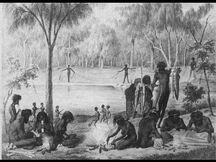
Artist's rendition of anangu people before the 15th century
It is generally believed that humans first arrived on the continent during the Upper Paleolithic Era, as the first region visited by humans outside of the Afro-Eurasian hemisphere. At this time, the landmasses of "Greater Shengdia", including Uluru, Papua, OTL Tasmania, and islands in between were unified as one landmass under the tectonic plate known as Sahul. This formed a common land bridge between the Austronesian areas, with a thin string of islands between the two continents that was later known as the Majapihit archipelago.
The exact date and route of migration is subject to considerable debate. Some point to the genetic similarities between the people of Uluru and Tondo. Others consider a strong linguistic connection between people of Uluru and southern China, before the genocides of the early Jin Dynasty. It is hypothesized that the Mount Toba eruption in ancient times compelled people to first migrate southward, and it took considerably brief time for the entire continent to be inhabited. Even after the land bridge disappeared in the last Ice Age, much cultural exchange existed between the Angu and Anangu people which introduced the Dingo to the continent around 3500 BC. Right up until the establishment of Uluru, various Bejau peoples from the East Indies would visit the north coast as trepangers.
Fire was an important innovation early on in the continent, helping the development of hunter-gatherer societies. Shortly afterward, however, over 60 species of mega-fauna in Anangeia went completely extinct very quickly. This is considered to be a combination of hunting, climate change, and fires, but the exact cause is uncertain. Some have even suspected that mass use of fire had significantly altered the climate. As the Ice Age came to a close, water levels on Sahul quickly rose, and the interior of the continent faced less and less rain until the current Inner Desert was formed as it is today around 2000 BC. Oral traditions tell of great floods that wiped out peoples as the water level rose in that area.
Transition to Agriculture[]
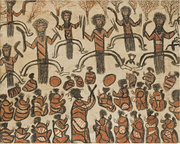
Contemporary depiction of the invention of agriculture
The Pama–Nyungan language family quickly dominated across from the Torres peninsula all the way southward, and throughout its prehistory the people across the continent shared similar traditions. Prior to the introduction of agriculture, anangu people lived stateless and in tribal, hunter-gatherer societies. Most people shared the same rank, and all disputes were settled by complex tribal law. Kinship traditions and coming-of-age rituals still applied, as well as ritual cannibalism in some areas.
In total, there is estimated about 300-500,000 people in Anangeia in the 15th century AD. Enough food for a balanced diet was plentiful, making it easy to maintain a hunter-gatherer civilization. Various innovations were developed over time to make gathering food easier, such as boomerangs and baked mud masks. The most developed civilization was the Murray culture in South Australia, using the fertile region to become semi-seditary. There particularly, fishing was an important means of hunter-gathering.
The prehistoric era established a tradition of reliance on memorization and mental pictures. Local shamans or Dreamspeakers would be walking encyclopedias of natural history with the information they internalized. As such, the native religion perceived the gods to exist in an unconscious world known as Dream Time, physically located on Mount Uluru. Art existed as a series of simple cave paintings, which morphed over time with the climate.
According to the earliest anangu myths, it was the Ngarridjeri tribe that were first gifted with farming sometime in the generation that preceded Tjilbruke. One story tells how the Dreamspeakers appealed to the First Ones during a time of famine, and was instructed on how to plant and harvest taro. At least by the time of Tjilbruke, a completely permanent civilization dependent on large-scale agriculture and farming was already present.
According to more recent archaeology, the first signs of proper agriculture appear around the middle of the 15th century AD, but had been steadily growing as a formative culture for centuries before that. Over a period of about ten years, the Ngarridjeri tribe started planting once a year while migrating, before changing to a chain of permanent villages. As social stratification emerged with the abundance of food, these villages merged together to form the first instance of the city-state of Ngarridjeri.
South Australian Civilization[]
Patriarchal Era[]
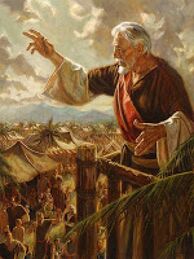
Tjilbruke instructing the anangu people
According to the Tjilbruke mythological cycle, his career in establishing the anangu civilization spanned a period of 12 years, each year consisting of a new miracle or commandment from Lord Ngintaka. It was in year 10 that the Ochre Chapel was constructed, which according to one inscription was 227 years old at the time the Uluru Empire was founded in 1697. Thus, the traditional dates of Tjilbruke's career are given as 1460-1472, with other events in the life of him and his family approximated from that. No contemporary archaeological evidence has been found for such an individual, but various monuments and paintings have been attributed to shortly after his death.
In year 1 (1460), Tjilbruke received his first vision, introducing Lord Ngintaka as the awakened god. In year 3 (1462), Tjilbruke received the covenant of Ngintaka, describing the natural laws and customs that became known as Tjilbruke's laws. It is at this point that he started being associated with miracles to confirm his messages. In year 5 (1464), Tjilbruke received his first vision from Mount Uluru, in which supposedly he saw images of the world's nations that existed at that time. It was around that time that Tjilbruke rose to such preeminence that he became almost the de facto monarch of the civilization, which is the first instance of the title Lord. In year 7 (1466), is when the romance story of Kulutuwi's marriage took place, the eldest son of Tjilbruke, who ultimately meets his wife Anjea. Finally, it was in year 9 (1468) that the construction of the Ochre Chapel began.
It is around this time that we first hear about the evil goddess Bila, as well as the monster Bunyip. In year 11 (1470), the Bunyip goes through various tactics to try to destroy Tjilbruke or his reputation, mainly resorting more to trickery rather than brute force. Ultimately, this results in Kulutuwi's sacrificial death in year 12 (1471), after which point Tjilbruke goes into retirement. It is generally believed that he died a few years after that, but other legends claim to encounter him as a hermit on Mount Uluru in very late eras.
In general, Tjilbruke is remembered almost like a prophet, but more closely to a noble patriarch. He is the singular origin point for most of anangu's later urbanized history. After his death, some obscure texts claim that his later descendants had dominion over the tribes until the rise of the Bakanate, but these are often in contradiction to the main narrative.
Rise of the Bakanate[]
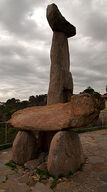
Contemporary monument of Tjilbruke mourning his son
Rather, the years after Tjilbruke's death are described as increasingly impious and barbaric, forsaking Ngintaka's commandments and using the newly-established technology for greed and wrath. Archaeologically, it seems that this era was defined more by rapidly-increasing urbanization, with permanent settlements all across South Anangeia, as well as increasing kinship by city-state. Around the 1480s, a series of conflicts broke out between cities known traditionally as the "Hunger Wars", caused by more fierce competition of resources. These conflicts led to the first construction of city walls, and ultimately the first organized local government known as the Bakanate.
One city that didn't make it out of this era seems to be Ngaduri, which supposedly was destroyed by the Bunyip one year before Djalu I took power. Exactly what happened to Ngaduri is up for archaeological debate, with the general consensus being it was destroyed in a flood. Historically, it served almost as a warning to the rest of the cities to be vigilant of their infrastructure and stability, or else suffer a similar fate.
The oral history that describes the predynastic era is rich in epic stories across multiple generations, focusing on the relationship between each city-state. As barely any contemporary historical records exist, the most reliable history are the collections of stories from later generations. The kinglist of Ngarridjeri, proudly retold in various Anangu inscriptions, gives the lengths or reigns for each Bakan over the city-state going back to Djalu I in 1488. The dates of other rulers from contemporary city-states are mostly inferred by their relationship to this main kinglist, although some smaller kinglists of other cities also exist. The most important fixed point of this era is the Fall of Noongar, the epic conclusion to the War of the Murray League traditionally dated to 142 years prior to the Uluru Empire in 1697, or 1555.
The system of Bakans in the predynastic era seem to have initially been elected or acclaimed out of popular demand, but early on biological kinship became significant. Even Djalu I, the first historical Bakan, gained power out of his close relation to the family of Tjilbruke. He was known as a generally wise administrator, but it's clear from the art he commissioned in Ngarridjeri that he was constantly having to justify his rule. One legend tells of how Djalu I's daughter Allira was married to the sun god Guwingkop twenty years into his reign, after a long and complex romance.
Predynastic Era[]

Bakan Jarrah overlooks the sack of Ngarridjeri
After 1488, every city-state has its own foundation story of how it came under the rule of a Bakanate, which presumably took place throughout the 1490s. In Kaurna, a cultural center, the first Bakan was a traveler named Colebee, who managed to out-wit a demonic Drop-Bear by answering its unsolvable riddle. He is also attributed to much of the city's early art and fashion.
After Colebee died, Kaurna seemed to decentralize between the rule of his sons, Thubbo I and Karuah. When Kaurna was ravaged with Black Fever around 1516, Karuah set out on an epic quest to restore Tjilbruke's ark to Mount Uluru, which allowed him to invoke Lord Ngintaka to end the plague. After Thubbo I died, he was apparently succeeded by Merinda, the daughter of Karuah. Merinda's legend is an unmistakably feminist story, describing how she held power by never marrying her entire life. Exactly how succession took place after her death is not known.
In Nukunu, the largest city, a man named Waku became Bakan after he managed to rescue them from a famine. Waku has many legends around his autocratic rule, and it has been argued whether this always refers to one person or multiple people under the same name. From 1499-1501 (by carbon dating), the domestication of kangaroo had led to the Leishmaniasis parasite (Black Fever) to mutate on humans, causing a massive plague in Nukunu. After Waku managed to stop the plague, it seemed that he had "cheated death", and further legends of Waku outwitting the Grim Reaper continue in later years.
Meanwhile, Nukunu became famous by the great engineer Mawukura. His legendary genius apparently stopped an invasion of Noongar using an Archimedes death ray, among other miracles. When Waku's son was infected with the demon Yaramayhawho, Mawakura designed the catacombs to keep him and his proxies imprisoned. As Waku started using the catacombs to store political prisoners, Mawakura attempted to quit the service, but instead was cast in himself. He supposedly escaped, but the next year an anonymous hero showed up and was able to rid the catacombs of demons completely, to the frustration of Waku.
Waku's ultimate fate was caused by a hero named Toba, who managed to trick him into seizing a cursed diamond that turned Waku into stone. A stone monument in Nukunu is claimed to be the final resting place of Waku to this day, perhaps being the origin of his myths related to immortality. It is generally believed Toba is the same person to clean out the catacombs of Nukunu, but this is not attested in the original sources.
Noongar Wars[]
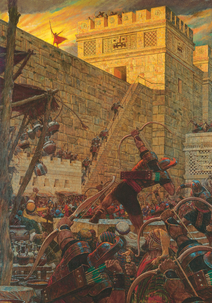
The fall of Noongar, 1555
Noongar had always been a rival viewed with suspicion by the other city-states, largely due to its cultural and economic divide. This started to escalate as Kangaroo Island was colonized in the early 16th century, since it contained resources key to the trade of both Ngarridjeri and Noongar. Noongar's first Bakan, Daku I, seems generally revered by his contemporaries, but at some point he was murdered by his brother or nephew Jarrah. Jarrah started reinforcing the settlements of Kangaroo Island, an act of aggression which provoked Ngarridjeri to declare war in 1509. This first conflict ended badly for the Murray people, as forces of Noongar invaded the valley and sacked several of the largest cities in 1510. According to legend, their invasion was forced out by a clever trick orchestrated by a soldier named Djalunager.
The first Noongar war was the start of a long series of conflicts known as the Noongar Wars. Around 1512, Black Fever ripped through Ngarridjeri, killing Djalu I among hundreds of others. Djalu II worked to develop the city's defenses against further wars, including forming the first Murray League with Kaurna, Nukunu, and Merkani. Around 1523, Allira's son Kinieger offered to marry Djalu II's daughter, but first he was presented with several herculean challenges to prove he was the son of the god Guwingkop.
After Djalu II died in 1527, his less favored son Wirrin seized the throne in a tyrannical rule. In an act of barbariety, he not only killed his brothers but proceeded to eat their children as well. One child named Kurna, however, was rescued when his mother substituted his body for wombat, and was raised in exile in Nukunu. In 1541, Kurna received a vision from his deceased father, instructing him to return to Ngarridjeri and overthrow Wirrin. That same year, Kurna arrived with an army from Nukunu and avenged his father's death.
Kurna's rule over Ngarridjeri marked a new change to the society of South Anangeia, marked by great social reforms and a more strict observance of Tjilbruke's laws. Piety of the people and respect of Dreamtime improved, and with it a greater international cooperation between the Murray states against their common enemies. The epic exploits of Kinieger, also attributed to this time, seem to mirror this moral reformation through his systematic slaying of allegorical monsters. His most famous act, if not the most widely attested myth in all this history, was the final slaying of the Bunyip, which also included the tragic death of his companion Toba.
1548-1555 is the traditional dates for the last Noongar War, more commonly known as the War of the Murray League. By the end of the war, Kangaroo Island was placed as a full vassal of Ngarridjeri, and the city of Noongar was completely leveled to the ground. It is believed to have lasted seven years, although some versions claim Noongar was actually besieged for seven years. Noongar would later be rebuilt, but apparently by completely different people. Although this act seemed to put the South Anangeia civilization close to political unification, the subsequent Ochre War a few years later caused Nukunu and Ngarridjeri to fall into war, thus shattering the league.
Overall, the pre-dynastic era was a time of rapid civilization growth, as the tight political and economic competition between the Bakanates forced each state to keep ahead in different technological capacities. At the same time, increasing communication and transportation allowed for greater homogeneity between the states, preparing the region for rule by a single state in later generations.
Anangu Kingdom[]
Omeo the Great[]

Omeo forges his magic sword
Omeo of Ngarridjeri, more commonly known as Omeo the Great, was the founder of the Anangu Kingdom, but his background is comparatively mysterious. His legendary, oral biography first surfaced in the 18th century, even later than the myths of the pre-dynastic era that proceeded him. The most reliable information comes from monumental inscriptions from the mid-late 16th century, which roughly dates his life to the 1560s.
According to the official account, Omeo was the son or half-brother of Kinieger, and some point after the Fall of Noongar he entered into a marriage alliance with Inala, daughter of Nyakul, and heiress of Nukunu. As Ngarridjeri and Nukunu still held a bitter rivalry, the Bakan of the city (sometimes identified as Kurna) banished Omeo from the Murray valley. Omeo still held a band of loyal followers, who went on a journey north following visions left by Lord Ngnintaka. Once they reached Mount Uluru, Omeo was instructed by the god to create his own forge, and there manufacture his own sword to Ngintaka's specifications. This item, hence known as the Sword of Omeo, has been attributed with many mystical powers.
With his divine sword and band of followers, Omeo assumed control over Ngarridjeri in a series of battles, before asserting his claim to Nukunu as well through his wife Inala. Omeo then re-organized the military to combine the forces of Ngarridjeri and Nukunu, and led a series of campaigns to assume control over all the city-states in the Murray Valley, proclaiming the establishment of the Anangu Kingdom. These and other wars are attested in the "Campaigns of Omeo" found on inscriptions throughout Nukunu, but exact dates are never given. After the first ten years of his reign, Omeo expanded east and west, until the entire South Anangeia civilization was under his domain.
During this same time, Omeo's wars pushed northward into the barbarian hinterland, in a conflict known as the Pitjantjatjara War. According to legend, the Bakan of the Pitjantjatjara committed an act of blasphemy by stealing the Ark of Tjilbruke, which justified the war. For the first time in its history, the Anangu civilization had direct control over the region of Mount Uluru, and Omeo capitalized on this. The White Chapel, the most sacred temple complex of the Ulurun traditional religion, was established across that mountain around twenty years into his reign.
Warring States Era[]

Daku the Fat and Nadi
Omeo in total reigned for 30 years, and when he died he left the kingdom in the care of his son, Daku. Daku seems to have been known as exceptionally incompetent, taking the unity of Anangu for granted and relying on the nations' greater opulence. During his comparably brief reign of ten years, an itinerant shaman appeared known as Nadi. Nadi claimed to be the "voice of Ngintaka" and spoke out against Daku and his hedonistic administration. Daku ultimately had Nadi arrested, but not before he opened up a prophesy against the Anangu Kingdom in general. He foretold that under the light of a blue moon, Daku would not live to see the sunrise. The story ends with the Dreamspeakers scoffing at this, so we never know what happened to Nadi.
During the night of a blue moon, Daku was then murdered by his servants, which almost didn't work due to his sheer obesity. It is debated by historians which new moon exactly he was murdered in. Most theories go between August, 1594 or December, 1599. After Daku's death, the nation seems to have completely collapsed, with almost every city-state, Bakanate, and in some cases individual tribes splitting off as their own faction. Known as the "Terrible War", this conflict was presumably caused by Daku having no clear heir to the throne.
Archaeology from the end of the 16th century reveals the absolute chaos and carnage that persisted during this period. Mass graves and depleted infrastructure are common to find from this era. After an uncertain period of time, a distant relative named Nyakul was chosen by the Dreamspeakers to be the new King, ending the conflict. However, the chaos and decentralization would continue for the next century, a period known as the "Anangu Warring States Era" or the "Age of Boomerangs". Although archaeology from this era is not as morbid as the Terrible War, life expectancy still appears to remain at a low.
During the Warring States, every individual Bakanate acted independently, with the King of Anangu more as a figure head. The area around the White Chapel of Uluru remained particularly independent, probably in response to their power over authorizing the King. Even so, the culture of anangu remained largely unified during this period. The common notion across the continent was to acknowledge the King as the traditional head of the civilization, even though he had no real power. In addition, each Bakanate and other nobility at this time was localized around separation nation-states, having grown out of the earlier kinship by city. Over time, closer and closer marriage alliances did well to unify all the Murray Bakanates as a single dynastic family, traced back to their common patriarch Tjilbruke.
This time is known as having scant information as well. As Murray Script gradually became more common, inscriptions on monuments and chapels became more frequent, occasionally giving reference to the king at the time. Murray Script as a full logographic language seems to have started in the mid 17th century, judging from a bark slate of judicial records found in Kaurna. Even then, detailed contemporary information was rare until the foundation of the Uluru Empire at the end of the century. Burial inscriptions are almost nonexistent, due to the prevalence of Anangu kings to be cremated.
Rulers of the Warring States Era[]
One chapel, called the Purple Chapel, records how it was constructed in the 8th year of Birrinbirrin, the son of Nyakul, and mentions how he reigned 10 years in total. As the chapel dates to 1619, then that put his reign from 1612-1621 approximately. The first Europeans to see anangeia was the French, who began exploring after 1608. No records exist of anyone from Anangu encountering Europeans, presumably due to their center of civilization being in the south. Around 1651, a French ship crash-landed in Anangeia, killing its crew but releasing horses into the wild. An undated inscription in Eore tells how King Thubbo was responsible for adopting horses into the royal military for the first time in their history. Indeed, the introduction of horses made massive changes to the culture of the South Anangeian civilization, who up until that time was vainly attempting to utilize kangaroo as beasts of burden.
The latter half of the 17th century presents some major confusion among the chronology of the Anangu Kingdom. Various inscriptions across the continent refer to three successive rulers: Jarli, Jarrah, and Omeo II all having reigned 12 years each. Certain indirect pieces of evidence, such as the coroner's bark in Ngarridjeri and the oral story of Djalu the Great, suggests that these were in fact successive reigns. However, two inscriptions located in the White Chapel and Dandiri reference a "King Djarrtjuntjun" dating to 1675 and 1678.
That Djarrtjuntjun is a rival king would make sense for the era, but it seems unlikely that he would be allowed in the White Chapel if not officially recognized. Some chronologies try to insert him between reigns, but none of them can be pushed back prior to the introduction of horses in 1651. Others have claimed that these aren't successive kings, but that Jarli, Jarrah, and Omeo II all refer to one ruler with three names. This seems anomalous, considering the Anangu has no tradition of taking on a regnal name. It remains a mystery to this day.
Foundation of the Empire[]

Yannathan before the Yolgnu War
In many versions of the account, the rise of Djalu the Great seems to purposefully mirror that of Omeo the Great. However, more reliable sources highlight the key differences. Born in Ngarridjeri to the Anangu King Jarrah, he was eventually married to the Bakan's daughter from Nukunu. However, in attempting to press his claim Jarrah exiled him from the court, on the account that his mother was a bastard. When Djalu eventually recovered the ancient Sword of Omeo, he proceeded to replicate his conquest by first besieging the city of Ngarridjeri, then subjugating each of the Bakanates in the Murray valley.
However, in 1694 Djalu invaded northward to besiege the White Chapel at Uluru. The Dreamspeakers there admonished Djalu for his actions, and Djalu in turn admired their fortitude. So at that stage, Djalu decided to abandon the kinship altogether, and instead adhere to the ideals of Ngintaka by establishing a full empire centered at the mountain. Once the Empire of Uluru was officially established, Djalu continued his campaigns to conquer entire southern half of Anangeia, which was completed in 1697. That date of 1697 henceforth became the year 1 of the Uluru calendar. The remainder of Djalu's reign focused on reconstructing the nation, putting a final end to the Warring States era. All previous Bakanates were completely annexed, and instead replaced with a series of tributary vassals under the imperial system.
Unlike Omeo, Djalu's son Dadu I was very competent and wise. Dadu created a standardization of Uluru's culture, officially adopting the Murray Script into the imperial court as an official written language. In addition, regulations were imposed to both art and economy persistent throughout the nation, creating the first banking system. The entire reign of Bambam I was made up of further conquests of the central Anangeia, known as the Second Pitjantjatjara War. Dadu II's reign was relatively peaceful, until he was murdered by his wicked uncle Wako in 1750.
Wako's coup launched the nation into civil war, between his imperial forces and that of Yannathan, Dadu's son. Yannathan managed to establish an alliance of northern tribes from their hinterland of anangeia, and began pressing his claim to the title of emperor in 1755. Meanwhile, Wako adopted a reputation of being a perverse ruler, gathering a large harem of attractive women from all across the empire. At the final stages of the civil war, Yananthan managed to utilize large flocks of wild emu at the forefront of his military. When Wako was defeated at the Siege of Noongar, he was subsequently drowned in the Murray River under the weight of his armor.
Yannathan's reign continued the cultural and technological advancements of previous generations, including the establishment of the Library of Ngarridjeri. Mathematics and astrology also grew tremendously during this time, which fed back to propaganda towards the Emperor as the rightful ruler of the universe. Most significantly, Yannathan led two large wars to unite the rest of the continent under a single rule. The first war, the Anangu Unification War lasted until 1766. Then finally the Yolgnu War conquered the non-Pama-Nyungan people in the far north of the continent, subjugating all as tributary vassals of the empire.
Administration[]
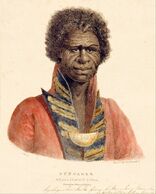
Bakan Jarrah right before his exile
The emperor of Uluru is the absolute monarch of the entire nation, and his personage singularly defines the existence of the state. The title of emperor evolved from the older title of "King of the Anangu", which is also added in the official title, but the purpose of the office is the same. The emperor is the single representative of not only all anangu people, but representative of the physical continent as well.
This office, as indicated in both its name and the name of the nation, is legitemized by the holy sanctuary of the White Chapel at Mount Uluru, as passed directly by the rule of the gods down to humanity. However, this does not indicate that the religious elite in the form of the Dreamspeakers have authority over the emperorship. There is no direct line of succession, but instead the office is willed manually just as any piece of property. All branches of the emperor's dynasty trace back their ancestry to Tjilbruke, the patriarchal founder of the entire Anangu civilization, who is revered above all other historical figures.
Uluru runs on a feudal system, and the feudal nobility under the emperor has individual responsibility to submit tribute to the monarch. The nobility also exists in a hierarchical structure: the majority of nobility are local Bakans, which best translates as "Duke". The Bakan rules over a state-unit, which encompasses multiple cities, but centered at his personal city-state of origin. Under the Bakan, each individual city-state or village complex is run by a local Tjila, or "Lord". There are occasionally also client "Kings" in the feudal system, mostly in the far north such as the Yolgnu Kingdom, but for the most part Bakans operate independently.
Kinship to specific cities is very strong, and royal families and dynasties are usually tied to their home city. The cities of the largest population are all clustered to the south, around the Murray River Valley system: Ngarrindjeri, Merkani, Ngadjuri, and Nukunu. Other important cities include Noongar, Eora (OTL Sydney), Dandiri (OTL Brisbane) and Tiwei (OTL Darwin). Complex road systems help connect the major cities together, and runners are among the most important civilian job of the empire. Having very little literacy, oral messages by runners are the most important means of fast communication, which since c.1650 were conveyed on horseback.
Law codes are also kept orally, but major cities would also inscribe outlines of the law on central pillars in the Murray Script. The oldest complete law code was developed in Nukunu in the early 16th century. Legal processions are dictated by local monarchs, and can vary between feudal lords as well as between local and national governments. Superceding the national law code, there are more sacred laws that have existed since the dawn of civilization known as the Tjilbruke laws, which are recorded in the Ochre Chapel.
Military[]

Royal Army of Uluru
The royal army of Uluru is divided into individual military units, with each unit led by a prince of the royal court. As the princes by blood were not necessarily trained in military strategy, they would always appoint captains from civilians to lead the command the unit in their place. Feudal nobility have private military as well, which are obligated to serve the Emperor first. The soldiers of the military are drafted from peasant classes between farming seasons, with the exception of the more elite Burnum class of soldiers who serve year-round.
As with most societies, warfare has existed on the continent since agricultural structures existed, starting with the mythological "Hunger Wars" in the late 15th century that supposedly led to the creation of organized government. As the civilization became more centralized, warfare was more directed against nomadic barbarians until the entire continent was unified by 1771. After that point, the royal army of Uluru was directed more internally to maintain control over the feudal lords.
Defensive tactics mainly fall under high city walls and fortifications, built mainly on baked mud bricks as well as granite. Due to the effectiveness of this defense, much military technology is built on the ability to besiege cities, such as the crow and the siege tower developed in the 16th century. Personal weapons mainly rely on the use of forged iron, including short-swords, spears, and javelins. Long range weapons have more variety, including arrows and non-returning boomerangs. The use of the boomerang is a very sacred tradition among the Uluru, having been passed down to each generation since long before recorded history. Chainmail armor has also existed in Uluru since the late 17th century, and is standard at least among the royal army.
Naval warfare was very significant in the predynastic era, during the rivalry of Ngarrindjeri and Noongar over control of Kangaroo Island. Although a modest navy of war-canoes still exist on the southern coast out of tradition, for the most part Uluru has no naval tradition and focuses its military entirely on land. In more recent years, larger barges from Yolgnu have also been designed to convoy navy.
Economy[]
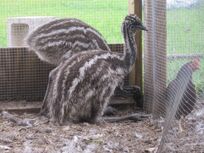
Emu being raised for the harvest
Uluru is primarily an agricultural society, and as such the economy revolves mainly around the production of agricultural products. Since the beginning of their history, the anangu have produced sugar, yams, and taro as the most important cash crops. Starting in the predynastic era, taro have been used as a stable currency. Ochre plants are also cultivated, but they are largely traded as a ceremonial dye and much less often consumed. In terms of protein, the Uluru mostly raise wombats and emu in captivity, breeding them for maximum fattening. Fishing is another source of meat hunted by communities on the southern and northern coasts. Large fishing ports are found along the coast of Adeleid, as well Kangaroo Island and the Yolgnu Kingdom. In ancient times, communication between Papua and northern Anangeia was common, but that had ended many millennia ago.
Dingoes, kangaroos and horses are the largest animals not used for consuming. Dingoes are important for hunting and occasionally combat, having been ubiquitous on the continent since prehistoric times. Kangaroos as pets are kept as signs of immense wealth, but are also used as a source of milk. Leather is manufactured across the continent by stretching kangaroo hides with wattle acid, a substance also used in making houses. Leather clothes have been popular since the predynastic era, often studded with diamonds and other precious minerals. Honey is also a large product, mainly in Western Anangeia, produced by collections of bees there.
Uluru's metallurgy is a very important facet of its civilization, and metals are gathered in a vast mining institution. Since the time of Tjilbruke, iron and copper are both used to manufacture all of anangu's weapons, including hammers, chisels, drills, and various weapons. In addition, diamonds and jewels are mined to create a plethora of jewelry, often colored in various dyes.
Due to difficulties in long-distance communication, a separate class of society are used as a form of salesmen, carrying manufactured products from one city to another for a personal fee. The 17th century started seeing dramatic changes, however. The introduction of horses were immediately used to expedite both communication and expansion. The development of Murray Script as a pictographic language c.1660 started to see it used by civilian artisans as well as salesmen.
List of Historical Rulers[]
Patriarchal Era[]
- Tjila of the People:
- Tjilbruke (lived c.1400-c.1475)
- Kulutuwi (lived c.1440-1471 or 1478)
- Kuluthoong (lived 1468-1525)
Predynastic Era[]
- Bakan of Ngarridjeri:
- Djalu I (1488-1512), 24 years
- Djalu II (1512-1527), 15 years
- Wirrin (1527-1541), 14 years
- Kurna (1541-c.1558), 13 years until the Fall of Noongar
- Omeo (c.1558-1560s), before becoming King
- Bakan of Nukunu:
- Waku (1498-1528), 30 years assuming the same person
- Toba (1528-c.1541), died early in Kurna's reign
- Nyakul (c.1541-c.1560), present at the Fall of Noongar
- Bakan of Kaurna:
- Colebee (c.1495-c.1510)
- Thubbo I (c.1510-c.1530)
- Lady Merinda (c.1530-c.1550), only confirmed female ruler
- Thubbo II (c.1550-c.1560), present at the Fall of Noongar
- Bakan of Merkani:
- Bunji (c.1490s), presumed founder
- Birrinbirrin (c.1510s), part of the first Murray League
- uncertain rulers here
- Darana (c.1550s), present at the Fall of Noongar
- Bakan of Noongar:
- Daku I (c.1495-c.1510), contemporary of Djalu I
- Jarrah (c.1510s), fought the first Noongar War
- uncertain rulers here
- Daku II (c.1545-1555), last ruler of Noongar
- Bakan of Ngadjuri:
- Payu (c.1487), "Lady of the Town", unofficially Bakan as Ngadjuri was destroyed that same yere
Anangu Kingdom[]
Uluru Empire[]
| Name | Reign | Image | Notes |
|---|---|---|---|
| Djalu the Great | 1694-1714 (20 years) | 
|
Founded the Empire |
| Dadu I | 1714-1731 (17 years) | Reformed administration | |
| Bambam I | 1731-1745 (14 years) | Led the Second Pitjantjatjara War | |
| Dadu II | 1745-1750 (5 years) | Murdered by Wako | |
| Wako | 1750-1755 (5 years) | Civil War with Yannathan | |
| Yannathan | 1755-1771 (16 years) | United all of Anangeia | |
| Bambam II | 1771-1781 (10 years) | Led the Angu War Discovered China and Europe | |
| Daku | 1781-present | Incumbent |
Culture[]
Religion[]
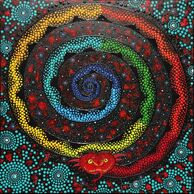
Bila, the rainbow serpent
The religion of Uluru is a polytheistic, semi-pantheistic religion that derives from the older traditional anangu religion from the prehistoric era. In general, the anangu religion sees a continuity between both the humanity and nature as part of the same spirit, and many of the traditional gods are representatives of aspects of nature, if not the nature itself. In the creation myth, the gods or "First Ones" first came to anangeia and created each aspect of the land. As such, every piece of geography on the continent has a unique story of its origin and meaning, often directly connected to its real scientific background.
After the time of Creation, the evil goddess Bila (the Rainbow Serpent) tricked the First Ones to go to sleep underneath Mount Uluru, and there they have been imprisoned ever since. Even asleep, the gods continue to guide the world and go about their tasks through a mystical process known as Dreamtime. The exception being Ngintaka, styled Lord Ngintaka, who is also called "the Awakened God". After becoming the only truly awakened god, and thereby chief of the gods, Lord Ngintaka revealed himself to Tjilbruke according to Ulurun mythology.
Lord Ngintaka is considered the most powerful and absolute monarch of the gods, as well as the guardian of the Uluru Empire. Bila, his opponent, is the mother of all mythological monsters, and enemy of all Ngintaka's children. This dichotomy between Ngintaka and his spiritual foes defines the cult of Ngintaka within the greater traditional anangu religion. The Bunyip, Kurreah's worst creation, is representative of flooding disasters. Other gods include: Kunapipi, spirit of the Murray River, Guwingkop, god of the sun, and Wuluwaid, god of the dead. Rather than being transcendent, each of the gods are described as being basically anthropomorphic in description.
The highest religious offices in the religion are Dreamspeakers, attributed with the spiritual ability to communicate with the gods in Dreamtime. The ceremony to access Dreamtime is conducted within a local chapel, which act as miniature temples. The most sacred of these are the White Chapel, located at the top of Mount Uluru, but the oldest is believed to be the Ochre Chapel in Ngarridjeri, which according to legend was constructed by Tjilbruke. Late in Uluru's history, the Dreamspeakers would appoint local representatives in the form of Shamans and Moornoons ("Parson"). Each of these can perform religious rites on behalf of Dreamspeakers, with Shamans being more mystical and Moornoons being more traditional.
According to mythology, Tjilbruke entered into a covenant with Ngintaka to obey a series of natural laws, and it is these that form the basis of Uluru's legal code. Cannibalism and common murder are forbidden, although many tribes outside the cult of Ngintaka are known to fall back into that custom. Marriage is basically polygamous, restricted based on class in society, although sex outside of marriage is forbidden. When someone dies, their body is placed outside for public mourning for a set period of months, which the entire community participates in. Afterward, the body and many worldly possessions undergo a smoking ritual in a local chapel, which is followed either by entombment or burning.
Based on a person's faithfulness to Ngintaka, his soul after death goes into the ground to live with the gods in Dreamtime, and Dreamspeakers have the ability to communicate with these souls as well. Souls in the afterlife also have the ability to return into the earth and be reborn as a new living creature. The closest thing to a scripture are a series of pictograms and petroglyphs that adorn the inside of the various chapels.
Language[]
The official language of Uluru is officially classified as the Pama-Nyungan language, but more informally known as the Anangu language. It varies wildly by dialect between different parts of the nation, sometimes even varying within a single city-state, but generally has kept standardized since the foundation of the empire. The Murray Imperial Dialect is the version used for official documents and conversing in the court.
In general, Pama-Nyungan is a dependent-marking, exclusively-suffixing language without gender. Many loan words from Papuan languages, however, include a prefixing system as well as complicated gender discrimination. Pama-Nyungan has a very limited vocabulary compared to other languages, and many different concepts are often represented by the same word. The phonology has a total of 21 sounds, including 3 vowels and 18 constanents.
The written language of Uluru started as a set of mystical symbols or petroglyphs inscribed in the oldest sections of the Ochre Chapel. These are attributed as written by Tjilbruke in response to his visions with Lord Ngintaka, meant to be read only by the highest Dreamspeakers. Over time, these symbols evolved into more ideograms during the predynastic era, and in some cases were used as pictograms for very official landmarks and inscriptions.
In the 17th century, the Murray Script had developed as a full logographic system, and over 300 distinct characters of this language have been identified. As only a minority of people in Uluru are literate, the Murray script is primarily used for official court and judicial documents, commercial records, and ritual texts. There is also a subset of 32 symbols used as a syllabic language, for the purpose of pronouncing proper names and places.
Art[]
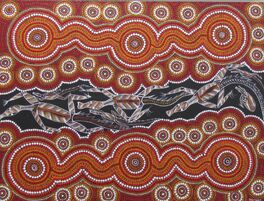
Example of bark art made with dots
The distinctive form and style of art in Uluru evolved from earlier forms in anangu tradition. The most common art take the form of painted or free-standing reliefs. Originally, these would appear in caves, but over time they moved to the inside of religious or public buildings. As the colored dye usually originate from local flora, the most typical colors used include yellow, brown, red, white, and black. Bark paintings are also common on large canvases of wood, which are usually filled with fine, intricate designs similar to meanders.
Far from being realistic, Ulurun art is rich in deep symbolism, depicting religious scenes of mythological events as well as the nature of the human soul. Yellow represents the sun, brown or red for the earth, white for the sky, and black for people. Human figures are simplistic except for key elements of clothing or instruments to distinguish their identity or roll. There is also a hierarchy of scale between young and old, ranks of nobility and theology. Early in the predynastic era, rock paintings and reliefs were used extensively keep record of important events in the city's history, which later evolved into the Murray Script langauge.
Large stone monuments are also common to see in the older cities of Uluru. Trilithons were first adapted in the predynastic era, probably in the city of Kaurna, and over time became more elaborate structures in honor of specific events. Early architecture is attributed to the legendary character Mawukura, who designed the oldest palace and underground catacombs for the city of Nukunu. Kaurna is also believed to be the origin of Ulurun fashion, crafting the first leather cloaks and turbans fitted with diamonds and other precious minerals. Metalurgy developed more complex jewelry such as necklaces and bracelets, usually enhanced with elaborate paints.
Various forms of fibercraft from bark and hair are also common, as well as various forms of pottery. Painted pottery are usually simplified versions of the rock paintings mentioned above.
Literature[]
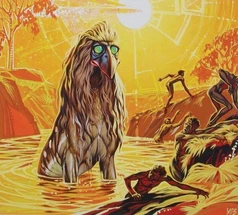
The Bunyip preparing to destroy Ngadjeri
Most of the literary tradition of Uluru derives from its oral history. The oral mythology of anangu is considered the oldest human historical record of any civilization, including detailed accounts of geographic changes that occurred many thousands of years ago. In the prehistoric era, it served to attribute individual meanings and personality to natural geographic features and monuments.
As the South Australian civilization formed, the oral history shifted to record epic tales of prominent and powerful leaders. This would often serve as moral lessons to help unify the cultures within the city-state, as well as the Murray culture in general. As writing became more common in the late 17th century, and especially grew during the early imperial era, it became more common to compile these epic myths and record their full stories as a single historical tradition.
Some of the more famous stories include the invention of farming, the life and visions of Tjilbruke and his sons, various epic heroes and monster-slaying during the predynastic era, the Noongar Wars, and the destruction of Ngaduri. There is also one anomalous myth involving Lord Ngintaka bidding farwell to the anangu before disappearing around the 1520s. This doesn't fit in the context of other stories, and is generally considered a spurious tale made by early atheists.
| |||||||||||||||||||||||||||||||||||





